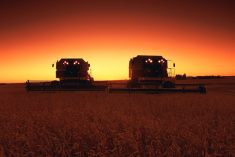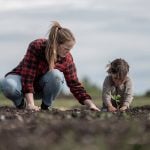Alberta farmers’ concerns with provincial policy, and the two major parties’ stances on those concerns, are the subjects of a three-part analysis leading up to a provincial election on Monday.
The Simpson Centre for Food and Agricultural Policy, a think tank operating out of the University of Calgary’s School of Public Policy, says its three recently released reports aim at “providing a neutral and evidence-based analysis of each party and their respective election priorities for the future of the ag sector.”
The reports, it said, “are intended to be a tool for agricultural organizations and stakeholders to use as a jumping-off point for discussions in the lead-up to the Alberta elections.”
Read Also

U.S. grains: Soybean futures rise on active Chinese buying
Chicago | Reuters – U.S. soybean futures edged higher on Friday on increased Chinese demand for American supplies. Wheat and…
The second of the three, titled Primary Producers’ Voices on Policy in Alberta, details results from a survey of 297 Alberta farmers and their concerns on the topics of climate, spending, markets/commodities/trade and technology/research.
The demographics of the farmer respondents were broken down into categories of 18-39, 40-60 and 60 and older.
Sixty-one per cent of respondents in the 18-39 group agreed their farm has been positively affected by federal climate change regulations. The two older groups did not view the situation the same way, however, with only 56 and 23 per cent agreeing respectively.
All demographics strongly agreed investment in research for emissions reductions should be a government priority.
The responses related to spending were not as decisive. On the question of whether the Alberta government provides strong incentives for new farmers to begin their careers, 51 and 52 per cent of the 18-39 and 40-60 groups voted they agreed, while only 21 per cent of those over 60 did.
Agreement that the government should prioritize subsidizing agriculture input costs was similarly tepid, ranging from 40 to 60 per cent.
The category of markets and commodities saw more noticeable agreement, however. All demographics generally agreed upon priorities related to the topic, such as opening up in new international trade markets, ensuring fair returns for commodity producers, incentivizing Albertan commodities and investing in new processing facilities.
Likewise, in the category of technology and research, every group agreed Canadian agriculture research has benefited their farms and investment in innovation technology in Alberta should be a high priority.
There was also consensus that the government should have significant involvement in the agriculture sector.
The first report, The Role of Political Parties in Shaping Agriculture Policy, outlines the track records of Alberta’s previous United Conservative Party (UCP) and New Democratic Party (NDP) governments.
According to the report, “the NDP government funded investments in research, food safety and animal health,” whereas “the UCP government has taken a direct-investment approach with Albertan producers and decreased ministry expenses for increased capital spending.”
The report’s conclusion states the NDP has emphasized increased protection for those working on the agriculture sector, and the UCP has focused more on giving control over to agricultural workers to make decisions about their individual daily operations.
It also concludes the NDP has focused more on research and funding the ministry of agriculture, whereas the UCP has prioritized direct investments.
It also notes many similarities between the two parties, however, such as how they have both invested in agribusiness.
The third report, An Overview of Party Visions, was just released Thursday and summarizes what the parties have promised in their platforms.
Among the more significant pledges were the UCP commitment to expand the Feeder Assistance Loan Guarantee from $2 million to $3 million, and the NDP’s promises to “create an Alberta value-added incentive program to help companies access capital,” create a food incentive task force and “increase staff for services and agri-food and value-added approvals.”
More about the surveys, party history and election pledges can be found in the full reports.
— Jonah Grignon reports for Glacier FarmMedia from Ottawa.














